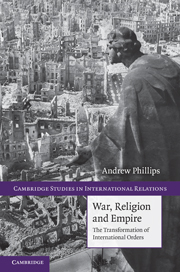Book contents
- Frontmatter
- Contents
- List of tables
- Acknowledgements
- Introduction
- PART I Conceptual framework
- PART II The historical transformation of international orders
- 3 The origins, constitution and decay of Latin Christendom
- 4 The collapse of Latin Christendom
- 5 Anarchy without society: Europe after Christendom and before sovereignty
- 6 The origins, constitution and decay of the Sinosphere
- 7 Heavenly Kingdom, imperial nemesis: Barbarians, martyrs and the crisis of the Sinosphere
- 8 Into the abyss: Barbarians, martyrs and the crisis of the Sinosphere
- 9 The great disorder and the birth of the East Asian sovereign state system
- PART III Contemporary challenges and future trajectories of world order
- Conclusion
- Bibliography
- Index
- Cambridge Studies in International Relations
4 - The collapse of Latin Christendom
Published online by Cambridge University Press: 10 January 2011
- Frontmatter
- Contents
- List of tables
- Acknowledgements
- Introduction
- PART I Conceptual framework
- PART II The historical transformation of international orders
- 3 The origins, constitution and decay of Latin Christendom
- 4 The collapse of Latin Christendom
- 5 Anarchy without society: Europe after Christendom and before sovereignty
- 6 The origins, constitution and decay of the Sinosphere
- 7 Heavenly Kingdom, imperial nemesis: Barbarians, martyrs and the crisis of the Sinosphere
- 8 Into the abyss: Barbarians, martyrs and the crisis of the Sinosphere
- 9 The great disorder and the birth of the East Asian sovereign state system
- PART III Contemporary challenges and future trajectories of world order
- Conclusion
- Bibliography
- Index
- Cambridge Studies in International Relations
Summary
Let no-one think that the world can be ruled without blood; the sword of the ruler must be red and bloody; for the world will and must be evil, and the sword is God's rod and vengeance upon it …
Martin LutherBy 1500 ce, Western and Central Europe remained integrated within the decaying but still discernible order of Latin Christendom. By the mid-seventeenth century, this order had been swept away, its place taken by an embryonic sovereign international order. The following two chapters chronicle the story of this transformation. In this chapter, I limit my analysis to the period beginning with the Reformation's onset in 1517 and concluding with the Peace of Augsburg in 1555. My purposes here are twofold. First, I aim to demonstrate how the systemic shock of the Reformation, working in conjunction with processes of geopolitical consolidation and institutional decay already evident from the late medieval period, worked to fatally undermine Christendom as an international order. Secondly, I seek to explain why Christendom's rulers were unable to collaborate either to save Christendom from destruction or to contrive a viable alternative once it became clear that the old order was beyond redemption.
Whereas Chapter 4 focuses on the immediate causes of Christendom's collapse, Chapters 5 and 6 explore the consequences of its collapse for Europe's subsequent evolution.
- Type
- Chapter
- Information
- War, Religion and EmpireThe Transformation of International Orders, pp. 83 - 106Publisher: Cambridge University PressPrint publication year: 2010

